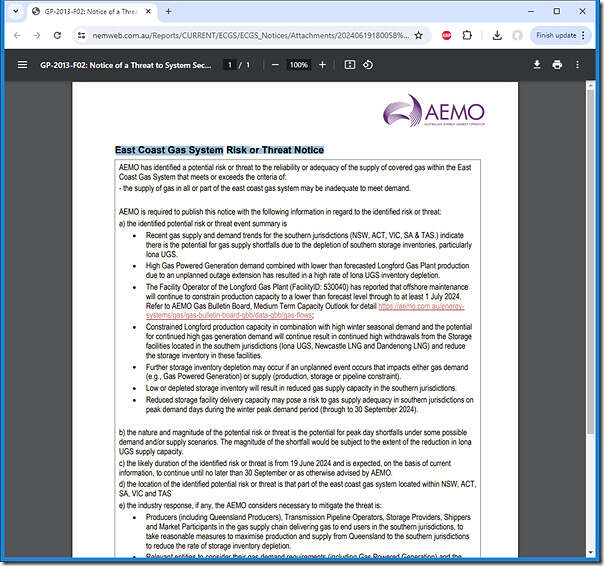On Wednesday 19th June 2024 (coinciding with a period of high gas usage for gas-power generation during Monday 17th June, Tuesday 18th June and Wednesday 19th June – especially for evening periods where IRPM dropped to quite low levels after sunset and with aggregate wind yields being at the lower end of the spectrum – the AEMO has published this ‘East Coast Gas System Risk or Threat Notice’:
The whole notice is worth reading (it’s only a page!) but it’s worth highlighting a couple things:
(A) It’s for a long duration … the remainder of Q2 and whole of Q3!
The notice says:
‘the likely duration of the identified risk or threat is from 19 June 2024 and is expected, on the basis of current information, to continue until no later than 30 September or as otherwise advised by AEMO’
… or, in other words, there’s not an easy fix to the challenge. Something that will play out in the back-drop when as we walk through 2024 Q3.
(B) Why are we here?
Some contributing factors are noted here:
‘the identified potential risk or threat event summary is
• Recent gas supply and demand trends for the southern jurisdictions (NSW, ACT, VIC, SA & TAS.) indicate there is the potential for gas supply shortfalls due to the depletion of southern storage inventories, particularly Iona UGS.
• High Gas Powered Generation demand combined with lower than forecasted Longford Gas Plant production due to an unplanned outage extension has resulted in a high rate of Iona UGS inventory depletion.
• The Facility Operator of the Longford Gas Plant (FacilityID: 530040) has reported that offshore maintenance will continue to constrain production capacity to a lower than forecast level through to at least 1 July 2024. Refer to AEMO Gas Bulletin Board, Medium Term Capacity Outlook for detail https://aemo.com.au/energysystems/gas/gas-bulletin-board-gbb/data-gbb/gas-flows;
• Constrained Longford production capacity in combination with high winter seasonal demand and the potential for continued high gas generation demand will continue result in continued high withdrawals from the Storage facilities located in the southern jurisdictions (Iona UGS, Newcastle LNG and Dandenong LNG) and reduce the storage inventory in these facilities.
• Further storage inventory depletion may occur if an unplanned event occurs that impacts either gas demand (e.g., Gas Powered Generation) or supply (production, storage or pipeline constraint).
• Low or depleted storage inventory will result in reduced gas supply capacity in the southern jurisdictions.
• Reduced storage facility delivery capacity may pose a risk to gas supply adequacy in southern jurisdictions on peak demand days during the winter peak demand period (through to 30 September 2024).’
Winter’s really only just started!



Related is that gas deliverability from Iona storage is itself dependent on storage volumes once the threshold limit is reached. Deliverability doesn’t simply stop when it’s empty but begins to decline well beforehand.
Plus the ability to refill storage is in all cases much slower than the ability to empty them. So a single day of low gas demand and storage filling cannot offset a day of high demand and storage withdrawal, the refilling process is considerably slower.
They’re seasonal storages, they’re not capable of refilling rapidly so once depleted it’s a slow process to refill.
You ARE on the Right side of Oz National energy grid history – please keep it up for the benefit of the technical understanding Oz citizens though now a little past it!